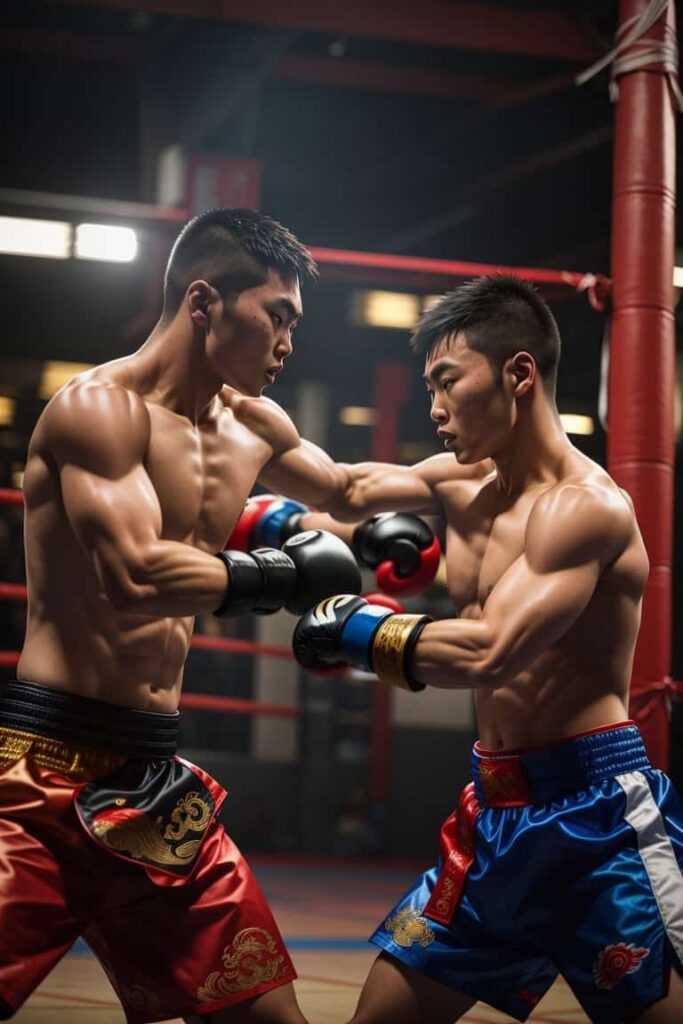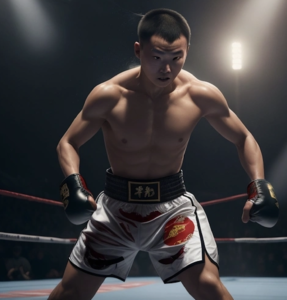Is Sanda effective. when it comes to real world self defense? And what about Sanda for Mixed Martial Arts?
In this post we look specifically at the question of is Sanda effective as a fighting style and the key features of Sanda as a stand up striking martial art that make this style effective or not.
Sanda: History as a fighting Style
The effectiveness of Sanda as a martial art is a subject of considerable debate and analysis within the martial arts community.
Sanda, also known as Chinese kickboxing or Sanshou, is a full-contact combat sport that combines elements of striking and grappling, making it distinct from traditional martial arts.
Sanda, also known as Sanshou, has its roots deeply embedded in Chinese martial arts history.
It emerged as a pragmatic combat training system that aimed to prepare practitioners for real-life self-defense and battlefield situations.
Sanda’s foundation lies within traditional Chinese martial arts, often referred to as Kung Fu.
These arts encompass a diverse range of fighting styles that originated and evolved over centuries in China.
Elements of striking, kicking, and various hand techniques found in Kung Fu were integrated into Sanda’s combat system.
In the mid-20th century, as China underwent significant social and political changes, traditional martial arts were adapted and modernized.
The establishment of the People’s Republic of China in 1949 led to efforts to preserve and promote traditional culture while also adapting it to contemporary needs.
Sanda emerged as a sportive expression of Chinese martial arts, aimed at providing a safe and regulated platform for practitioners to test their skills.
Sanda was developed by integrating techniques from various traditional Chinese martial arts styles, including striking techniques from northern and southern Kung Fu styles, as well as elements from wrestling and throwing techniques.
In the latter half of the 20th century, Sanda gained international recognition and exposure as China participated in various martial arts competitions and exhibitions.
This helped spread awareness of the art beyond China’s borders.
Today Sanda is China’s most popular combat sport.
Every province in and major city in China has a professional club that houses competitive Sanda fighters.
At traditional wushu (martial arts) clubs across China, Sanda is also taught alongside the traditional wushu styles.
Sanda’s Fighting Techniques & Strategies
Sanda’s main techniques and fighting strategies reflect its emphasis on practical combat and adaptability.
Let’s look at the main fighting techniques and strategies within the fighting art of Sanda.

Striking Techniques:
- Punches: Sanda practitioners use various punches, such as jabs, hooks, crosses, and uppercuts, to target an opponent’s head and body.
- Kicks: Kicks play a prominent role in Sanda. Practitioners execute high kicks, low kicks, roundhouse kicks, front kicks, and spinning kicks to create openings and keep opponents at bay.
- Knee Strikes: Knee strikes are effective at close range, often utilized in clinch situations to target an opponent’s midsection or thighs.
- Elbows: Although less emphasized than in some other martial arts, Sanda practitioners may use elbows to deliver powerful strikes, especially in close quarters.
Grappling Techniques:
- Throws and Takedowns: Sanda incorporates a variety of throws and takedowns, often initiated from the clinch. These techniques aim to destabilize opponents and bring them to the ground.
- Clinching: The clinch is a crucial aspect of Sanda. Practitioners engage in close-range grappling, using techniques like knee strikes, sweeps, and trips to control and manipulate their opponents.
- Escapes and Counters: Sanda practitioners learn how to escape from unfavorable clinch or grappling positions and how to counter an opponent’s takedown attempts.
Fighting Strategies:
- Distance Management: Sanda fighters are skilled at controlling the distance between themselves and their opponents. They use footwork and range to their advantage, transitioning between striking and clinch range as needed.
- Combination Attacks: Effective Sanda fighters often employ combinations of strikes to overwhelm opponents and create openings for takedowns or follow-up strikes.
- Feints and Timing: Feints are used to deceive opponents and provoke reactions, allowing Sanda practitioners to exploit openings or set up effective strikes and takedowns.
- Clinch Control: Clinch work is a fundamental component of Sanda’s fighting strategy. Practitioners aim to establish and maintain control in the clinch, utilizing knee strikes, sweeps, and throws to gain an advantage.
- Adaptability: Sanda places a strong emphasis on adaptability, training practitioners to transition seamlessly between striking and grappling based on the situation at hand.
- Defensive Techniques: Effective Sanda fighters are skilled in evading and blocking strikes, as well as using parries and slips to minimize damage and set up counterattacks.
- Ring Awareness: Sanda fighters must be aware of their position in the ring to avoid being trapped or cornered. Ring control and movement are crucial for effective strategy.
Sanda’s techniques and strategies are designed to prepare practitioners for a wide range of combat scenarios, both in controlled sporting competitions and real-life self-defense situations. Its integration of striking and grappling makes it a well-rounded martial art that emphasizes practicality and adaptability.
What Makes Sanda Effective as a Fighting Art?
There are several characteristics of Sanda that make this style effective in both combat aports and real world fighting.
Self-Defense:
Sanda’s practicality in real-life self-defense scenarios is a point of contention.
The training in striking and grappling techniques, along with its emphasis on adaptability, can provide practitioners with tools to defend themselves effectively.
However, like any martial art, success in self-defense depends on a practitioner’s skill, training, and ability to adapt to dynamic situations.

Versatility:
Sanda’s focus on both stand-up striking and clinch work can contribute to versatility in combat situations. Its inclusion of throws and takedowns can be valuable in close-quarters encounters, enhancing its potential effectiveness in practical situations.
Physical Fitness:
Sanda training involves rigorous conditioning, which can lead to improved cardiovascular fitness, strength, and agility. This physical conditioning can be advantageous in various contexts, including self-defense and overall well-being.
Competitive Combat:
As a combat sport, Sanda provides a platform for practitioners to test their skills against opponents in controlled environments. Competing in Sanda can help practitioners develop a sense of timing, strategy, and adaptability, which can translate to effective combat skills.
Cross-Training Potential:
Sanda’s integration of striking and grappling techniques could make it a valuable addition to a martial artist’s toolkit, especially when combined with other martial arts. Cross-training can enhance a practitioner’s ability to handle different combat scenarios.
Limitations of Sanda as a fighting Style
While Sanda has strengths, it also has limitations.
Its ruleset and focus on sportsmanship in competition may lead to certain techniques or strategies being underrepresented.
while Sanda draws from traditional Chinese kung fu styles which were almost completely focussed on self defense, Sanda’s focus on ring competition means some self defense techniques which are effective in street fighting with no rules may be neglected.
For example, Chinese kung fu is known for efficiency and attacking the weak and vulnerable points of the human body such as the eyes, throat and groin area which are illegal techniques in Sanda competition.
Additionally, the absence of ground-fighting techniques and submissions, common in other martial arts, could limit its effectiveness in certain situations, especially for application in mixed martial arts competition.
Is Sanda effective? Wrap Up
Overall Sanda is a very effective stand up striking as well as grappling and takedown style.
Sanda was developed to be used in the military as well as in combat sports and as such the most effective techniques were integrated into the development of Sanda.
As both a stand up striking and takedown style, Sanda is quite versatile which adds to it’s fighting effectiveness.
however there are some limitations which are quite notable when it comes to Sanda’s effectiveness in self defense as well as potential for training to be used in mixed martial arts and these have been discussed as well in this post.



